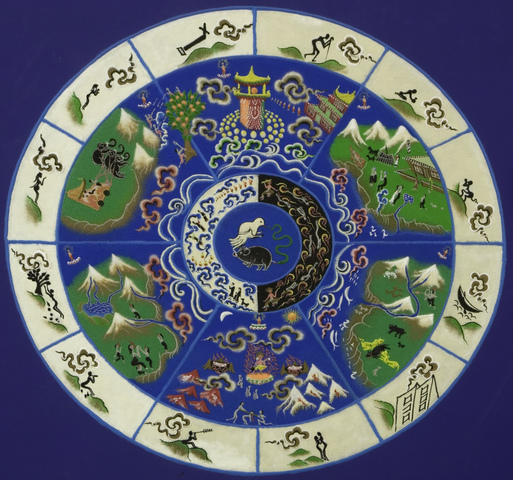
| At MIT |
|
|
|
|
|
|
|
|
|
|
|
|
|
|
|
|
| Prajnopaya Links |
| The Prajnopaya Foundation |
I respectfully urge you who study the mystery,
don't pass your days and nights in vain.
Sekito Kisen, Sandokai
The Wheel of Life
March 3-10, 2007
at the Massachusetts Institute of TechnologySand Mandala opening ceremony and reception
Tuesday, March 6 at 7PMSimmons Hall | 229 Vassar Street | Cambridge | MA
Courtesy: Fredo Durand
Mar 6: Sand Mandala Opening Ceremony and Reception | 7PM | MIT Simmons Hall
Mar 8: Compassion in Medicine| A Talk by Dr. Michael Grodin | 7PM | MIT Simmons Hall
Mar 10: Sand Mandala Dissolution Ceremony | 2PM | MIT Simmons Hall
Mar 15: Social Intelligence | A Talk by author Daniel Goleman | 5PM | MIT Simmons Hall
April 26 : Training the Mind: From Stress to Bliss | A Public Talk by Robert Thurman (Please register or purchase a ticket for this talk)
Panorama views (full image list):


Kids' Mandala Workshop (images courtesy Fredo Durand)
YouTube video:
If the movie didnt automatically start playing, you may need to install the plugin. Alternatively, you can download the video here:
Time lapse of the creation.____________________
Sand Mandala general public viewing hours:
Mon-Fri, Mar 5-9: 11AM- 2PM and 4PM- 7PM
Saturday, Mar 10: 11AM-2PM (Dissolution Ceremony at 2PM)
Note on Parking: Free parking is available in MIT West Lot after 5PM during the Sand Mandala week. Metered street parking is available on Massachusetts Avenue and Vassar Street.
About Mandala at MIT:
The purpose of this project is to increase social and cultural awareness in the participating communities by exploring the various dimensions of aesthetic and contemplative traditions. Art, music, and storytelling will be among the diverse disciplines we explore. Through these community-building exercises, we will help students share and develop a more positive attitude by acquiring basic tools for conflict resolution and peace building.
Mandala @ MIT is a visionary and reflective exercise that hopes to encourage young minds to visualize and meditate about the positive qualities that they would like to see manifested in the world. It motivates them to express their ideas through art by symbols and patterns. The representation of positive qualities in an ideal world in the form of an artistic pattern has often been referred to as mandala by several cultures.
This year's project:
The Sand Mandala of Wheel of Life will be hosted at the Multi-purpose Hall, Simmons Hall at MIT. We are planning on constructing a 5-foot Mandala which will take 5-6 days to complete. It will be open for viewing at all times to the MIT community and at scheduled times to the public. We are expecting a public of around 5,000 viewers. Additionally, there will be a webcast, so that others may view the Mandala remotely.The Tibetan culture is one of the most ancient of our planet and it is highly endangered. Among the Tibetan arts, sand Mandala or painting with colored sand, ranks as one of the most unique and exquisite. The Mandala is an ancient art form of Tibetan Buddhism. It is constructed as a vehicle to generate compassion, realize the impermanence of reality, and a social/cosmic healing of the environment.
Millions of grains of colored sand are painstakingly laid into place on a flat platform over a period of several days, forming an intricate diagram of the enlightened mind and the ideal world. The most common substance used is colored sand, which is ground from stone. When the sand Mandala is completed, to symbolize the impermanence of all that exists, the colored sands are swept up and poured into a nearby river or stream where the waters carry the healing energies throughout the world.
Sand Mandala construction will be led by the Venerable Losang Samten, a renowned Tibetan scholar and a former Buddhist monk. Ven. Losang Samten was born in Chung Ribuce, in Central Tibet. In 1959, he and his family fled to Nepal and later moved to Dharamsala, India. His education includes studies at the Tibetan Institute of Performing Arts and the Namgyal Monastery which is the monastery of the 14th Dalai Lama. In 1985, he earned a Master's Degree in Buddhist Philosophy, Sutra, and Tantra, from the Namgyal Monastery, which is equivalent to a Ph.D. In 1994, Losang received an Honorary Doctorate of Divinity from Trinity College in Hartford, Connecticut. He was granted an Honorary Doctorate of Art from the Maine College of Art in 1995.
He will be assisted by the Venerable Tenzin Priyadarshi of MIT.
Sand Mandalas at MIT in Review:
MIT has hosted two traditional Sand Mandalas, in 2004 and 2005, which were constructed by members of monasteries in India, the Buddhist community at MIT and Ven. Tenzin LS Priyadarshi. The project in 2005 attracted 3,800 people to Simmons Hall to observe the construction of the Mandala and an additional 2,300 people were able to experience the Mandala over a live webcast. The Mandala Project in 2006 was an outreach program that involved various schools and colleges in the United States. Students explored the topics of diversity, impermanence, acceptance, and the value of peace through various workshops.
Co-Sponsored By:
MIT Prajnopaya- The Buddhist Community at MIT
Residential Scholar's Program at Simmons Hall
Generous gift from William R. (1956) and Betsy P. Leitch
The Prajnopaya Foundation
The Impact Foundation
MIT Office of Religious Life
MIT LEF, LEM, Tech Catholic Community
MIT Dean of Student Life
MIT Residential Life Programs
MIT LEF - Large Event Funds
The MIT Fund
Dean Barbara Baker

